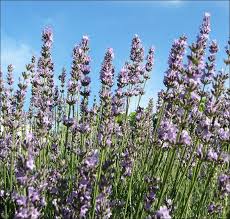Lavandula angustifolia
Lavandula latifolia
LABIATEAE = LABIATEAE

The lavender shrubs are typical of the Mediterranean (warm climate is dry for several months in summer, rainy winter and spring) and they grow well in limestone soils in medium and low altitude (0 to 800m).
The plants are very aromatic foliage discreet, green or gray ash, and inflorescences slender spikes or clusters in blue-violet flowers.
The species officinale in France is Lavandula angustifolia (angustifolia) = L. = L. officinalis vera, another wild species (lavender) is less used: Lavandula latifolia (broadleaf) = Lavandula spica.
There are hybrid forms of natural fruit agronomic selections: the lavender: Lavandula intermedia = Lavandula hybrida; hybrids or varieties of crops (cultivars) are the subject of industrial crops, especially in Provence (essential oil yield improved varieties Oil key to precise chemical composition (chemotyped)).
Lavandula stoechas is another common species in gardens in France, it has flowers larger with decorative foliage.
The Mediterranean lavenders have been widely used and are grown worldwide but there are other indigenous lavender (in Asia, the Middle East, North Africa).
The inflorescences and essential oils are medicinal
COMPOSITION AND CHEMICAL PROPERTIES
The chemical composition and quantity of essential oil of lavender vary depending on growing conditions, season of the crop variety and even the extraction technique.
Here's an example from a document Agronomy:
2000 to 3500 kg of fresh flowers per hectare results in 400 to 700 kg of dried flowers and 15 to 35 kg of essential oil.
To be "officinale" the lavender essential oil must contain 25 to 38% of linalool (alcohol), 25 to 45% linalyl acetate (ester), 0.1 to 0.5% limonene (monoterpene) 0.3 to 1.5% of cineole
(= Eucalyptol), 0.2 to 0.5% of camphor (monoterpene), 0.3 to 1% alpha-terpineol (alcohol).
Other standards require a minimum content in specific compounds: 0.3% lavandulol and 2% of its acetic ester.
The essential oil also contains eugenol, caryophyllene.
The essential oil of lavender 'Grosso' is also officinale, its composition is close to that of lavender: 25 to 35% linalool, 28 to 38% linalyl acetate, 4 to 7% cineole, 6 8% camphor oil is camphor so much less "nice".
The essential oil of lavender has a composition very different from the variety officinale: generally much camphor (up to 20%) and cineole (up to 40%), it is less appreciated.
The inflorescences of lavender contain other pharmacologically active compounds: flavonoids, phenolic acids (rosmarinic, caffeic)
The essential oils of lavender and lavender officinal are:
* Moderate antibacterial and antifungal
* Calming, anxiolytic, sedative, antispasmodic
* Analgesics (general and local)
* Healing
* Insect repellent
* May be slightly hypoglycemic
USES
The flowers or inflorescences of lavender (officinale, asp, hybrids) are harvested at maturity.
We can make an alcoholic tincture containing terpenoids of the essential oil.
We obtain the essential oil by steam distillation of flowers, we shall be distilled as soon as possible after harvest (to avoid fermentation of the plant mass and loss of essential oil is very volatile).
The therapeutic indications of lavender are a function of its pharmacological properties.
External Use
(beware some people are allergic to essential oils of lavender different):
* Wounds and burns (to the 2nd degree as sunburn) or recent infection: one can use a concentrated infusion, the alcoholic tincture or essential oil pure or diluted 1 / 10 in alcohol 60 ° ; oil calms down a little painful burns component
* Shingles is also an indication: essential oil of lavender pure topical seems to reduce pain and shorten healing time of skin vesicles
* Dermatoses of fungal origin in combination with other essential oils (like the "tea tree" for example)
* Leucorrhoea: in fungal infections can sometimes get good results by incorporating the essential oil of lavender directly to a gynecologic liquid soap
* To eliminate head lice: a few drops of lavender essential oil directly on the hair styling, once or twice a week, or mixing the essential oil of lavender shampoo (10 drops in a big spoonful soup shampoo) but is less effective.
* Conventionally to eliminate or deter insect cabinets (a cloth bag filled with dried lavender flowers)
Internal Use
* Respiratory infections (acute or chronic bronchitis, sinusitis), GI (gastro-enteritis, colitis), urinary tract (cystitis, urethritis): 2 to 3 drops 3 to 4 times per day in honey, a sugar cube or a little condensed milk.
* Difficulty falling asleep, insomnia, mild anxiety, nervousness: several studies show that the essential oil of lavender is calming, sedative, especially in the elderly.
example: 2 g of lavender flowers (plus or minus two teaspoonfuls) in a bowl of hot water, infuse 5 to 10 minutes in the evening 1 / 2 to 1 hour before bedtime.
example:
* For mild anxiety (2 to 3 drops of essential oil (lavender) 3 times a day);
* To facilitate sleep (2 to 4 drops of essential oil (lavender) 1 / 2 hour to 1 hour before bedtime).
The essential oil of lavender
is a little analgesic and antispasmodic:
* Rheumatic pain (3 to 4 drops 2 to 3 times daily by mouth and massage around the painful area with a few drops of pure essential oil or diluted in massage oil (20 drops of essential oil Lavender in 10 ml of massage oil (eg almond)
* Dysmenorrhea the girl: slight alleviation of pain and spasms, with 3 to 4 drops of essential oil 3 times daily, starting 2 days before menstruation.
CAUTION:
* Do not exceed recommended dosage because the essential oils of lavender (officinale, asp, lavender) are toxic in high doses (like most other essential oils).
* Some people are allergic to lavender (asthma, eczema)
The extracts of lavender are used in cosmetics and perfumery
0 commentaires